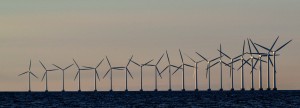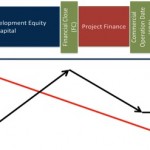The installation of more than 100 wind turbines off the coast of the United States is now a near certainty. The first power is expected to flow from the turbines during 2013.
Cape Wind Associates plan to build 130 wind turbines with a generation capacity of 420 MW near the island of Cape Cod, Massachusetts, off the North East coast of the US. The Massachussetts state regulator has approved a Power Purchase Agreement (PPA) between the utility NSTAR Electric and offshore wind project developers, Cape Wind Associates.
The NSTAR PPA will account for 27.5% of the projects output. A PPA with National Grid USA for 50% had already been signed and approved in 2011.
The birth of U.S. Offshore wind power has been tortuously slow. The Cape Wind project has faced down challenge after challenge for more than a decade. Despite strong political support it has constantly hit obstacles.
The sale of more than 75% of the power makes construction of three quarters of the turbines viable. Mark Rodgers, Communications Director for Cape Wind, told the press: “We are moving forward financing the project on the basis of the PPAs we have, 77.5% translates to 101 wind turbines. When we sell additional power we will seek additional financing for that.”
Power price
NSTAR has signed up to purchase the power from 129 MW of Cape Wind’s offshore generation over 15 years at a “base price” of $187 per MW/h.
(The actual price paid will be adjusted up or down according to a range of factors, such as the cost of financing and the speed of progress in constructing Cape Wind. An upper limit of $193 per MW/h has been agreed.)
Cape Wind’s electricity will be very competitively priced, compared to offshore power generated on the Eastern side of the Atlantic. Electricity from the UK’s 1.34 GW of offshore wind costs around $270 per MW/h.
The regulator approved the PPA on the grounds that the Cape Wind facility will have beneficial effects on: the supply and demand of renewable resources; compliance with emission reductions requirements; contribution to fuel diversity; price suppression effects; a hedge against future fuel price volatility; system reliability; and it will help to moderate system peak load. It would also help relieve stresses on the region’s transmission grid.
There is considerable potential demand for Cape Wind’s output. Combining the power from Cape Wind with all of the planned land-based wind and solar projects in Massachusetts is still not enough to meet the demand for clean energy as mandated by state law by the New England states.
Overwhelming public support
The project has faced some fierce law suits by locals. But Rodgers says the opposition has achieved amuch higher profile than their size justified. “Cape Wind is not only supported by all the major national and local environmental organizations, but we also have an overwhelming public support of the people of Massachusetts, and even a majority support right on the island of Cape Cod.”
There are national interest groups, particularly from the coal and oil sectors, that work to undermine support for renewable energy, says Rodgers. “They are buying the debate,” he says. “ In the US you can’t watch a television news broadcast or watch news content over the internet without an associated advertisement on almost every occasion fro the oil, gas or coal industries. Their message is a constant and incessant drum beat. They certainly avail themselves of the political process as well.”
During a 2011 interview with www.leonardo-energy.org, Mark Rodgers said: “Our plan is to build the project at full scale. Obviously we have other alternatives including a smaller scale project, but we continue to work on building the full project.”








No comments yet.